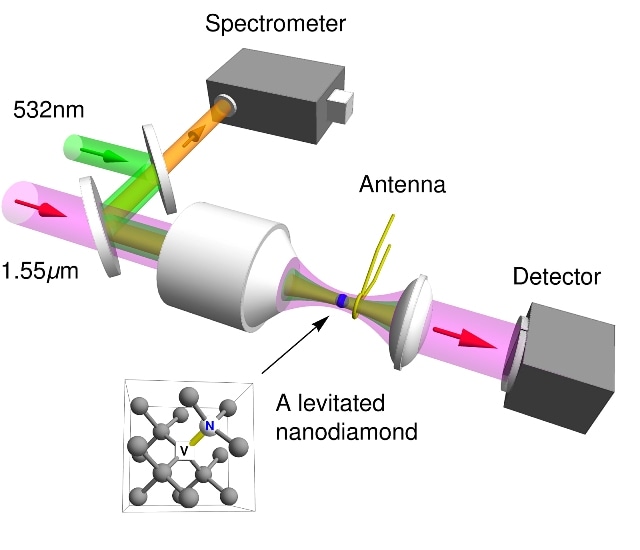Jul 21 2016
A team of researchers have demonstrated a way to manipulate the "electron spin" of a nanodiamond when it is levitated using lasers in a vacuum. This innovative method has potential in applications spanning across sensors, quantum data processing, and studies covering the fundamental physics of quantum mechanics.
 This is a schematic of an optical tweezer used in a vacuum chamber by Purdue University researchers, who controlled the "electron spin" of a levitated nanodiamond. The advance could find applications in quantum information processing, sensors and studies into the fundamental physics of quantum mechanics. (Photo credit: Purdue University image/ Tongcang Li)
This is a schematic of an optical tweezer used in a vacuum chamber by Purdue University researchers, who controlled the "electron spin" of a levitated nanodiamond. The advance could find applications in quantum information processing, sensors and studies into the fundamental physics of quantum mechanics. (Photo credit: Purdue University image/ Tongcang Li)
Electrons can be imagined to possess two distinct spin states, "up" or "down." The researchers were able to spot and manipulate the electron spin resonance, or its transformation from one state to the other.
We've shown how to continuously flip the electron spin in a nanodiamond levitated in a vacuum and in the presence of different gases.
Tongcang Li, Assistant Professor, Purdue University
Levitating Nanodiamond Research
The research paper has been published in the Nature Communications journal.
In the presence of oxygen and helium gases, it was revealed that electron spin resonance differed, which meant that the method could be used in a new type of sensor to spot and measure gases.
Oxygen gas sensors are widely used to monitor the concentration of oxygen in medical instruments such as respirators and anesthesia monitors, and in automotive exhaust.
Nanodiamond-based sensors signify a potential development over traditional sensors.
While more detailed studies are required to fully understand this phenomenon, our observation suggests a potential application for oxygen gas sensing.
Tongcang Li, Assistant Professor, Purdue University
The research paper was authored by postdoctoral research associate Thai Hoang along with doctoral students Jonghoon Ahn and Jaehoon Bang; and Li.
The levitating nanodiamonds have the potential to be used in experimental methods to probe fundamental physics in quantum mechanics, quantum information processing, and the measurement of gravitational and magnetic fields, which could be applied to computer memory and experiments to locate for deviations from Newton's law of gravitation.
When the nanodiamonds are levitated in a vacuum, precise control and meticulous measurement of the floating particles is possible.
The nanodiamonds measure approximately 100 nm in diameter, or about the size of a virus. They comprise "nitrogen vacancy centers" vital to probable practical applications. A nitrogen-vacancy center is an atomic-scale defect that is formed in the diamond lattice by replacing a nitrogen atom for a carbon atom and developing a neighboring void in the crystal lattice. This feature can be exploited by researchers to manipulate the electron spin.
Trapping and levitating the nanoparticle in a vacuum chamber was achieved using one type of laser. Monitoring the electron spin was performed using another type of laser. A millimeter-scale antenna provides microwaves to direct and flip the electron spin, and a spectrometer spots these alterations in the spin. Vacuum is required to decrease interference from air molecules.
Quantum computers make use of phenomena illustrated by quantum theory called "superposition" and "entanglement."
Computers built on quantum physics may significantly increase the capacity to process, store and convey data.
One long-standing goal of the Purdue research is to apply the method to analyze the well-known Schrödinger's cat thought experiment, in which a cat could be both alive and dead at the same time.
We want to put a single nanodiamond at two different locations at the same time.
Tongcang Li, Assistant Professor, Purdue University
The National Science Foundation supported the research.